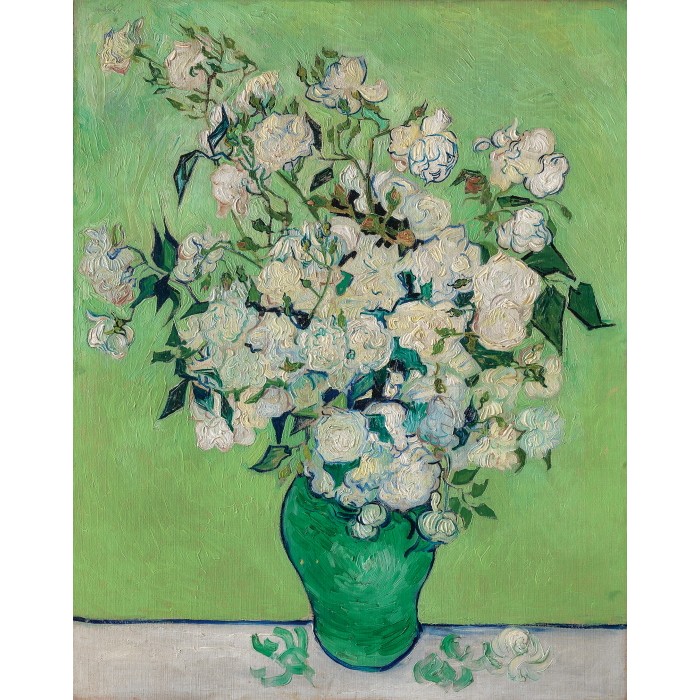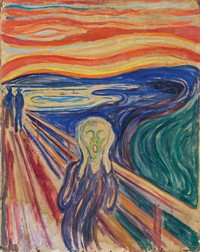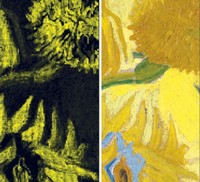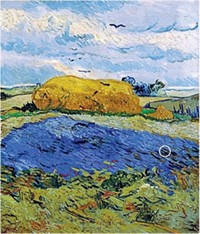Advertisement
Grab your lab coat. Let's get started
Welcome!
Welcome!
Create an account below to get 6 C&EN articles per month, receive newsletters and more - all free.
It seems this is your first time logging in online. Please enter the following information to continue.
As an ACS member you automatically get access to this site. All we need is few more details to create your reading experience.
Not you? Sign in with a different account.
Not you? Sign in with a different account.
ERROR 1
ERROR 1
ERROR 2
ERROR 2
ERROR 2
ERROR 2
ERROR 2
Password and Confirm password must match.
If you have an ACS member number, please enter it here so we can link this account to your membership. (optional)
ERROR 2
ACS values your privacy. By submitting your information, you are gaining access to C&EN and subscribing to our weekly newsletter. We use the information you provide to make your reading experience better, and we will never sell your data to third party members.
Lab Safety
Van Gogh’s Fading Colors Inspire Scientific Inquiry
Lessons learned from the chemical breakdown of pigments in the Post-Impressionist’s masterpieces
by Sarah Everts
February 1, 2016
| A version of this story appeared in
Volume 94, Issue 5
Vincent Van Gogh was obsessed with the pigments in his paints, and he knew as much or more about their composition and vulnerability as many of his contemporaries. So it is a tragic irony that many of the bright red and yellow pigments van Gogh used on his masterpieces are fading or changing color with time.
Pigment breakdown is, of course, not just a problem with van Gogh’s oeuvre: He was using many of the same pigments as other late-19th-century Northern European artists such as Pierre-Auguste Renoir or James Ensor. “You can safely say that many works from that period have probably been affected in some way by similar pigment issues,” says Ella Hendriks, senior conservator at the Van Gogh Museum, in Amsterdam.
Yet the artwork of van Gogh has become a lens through which scientists study pigment degradation. He was a prolific painter—in the 10 years he was active as an artist, van Gogh produced nearly 1,000 paintings. He was also a prolific writer: In letters to family and friends, he discussed in detail the pigments he purchased and the colors of his newly painted canvases. These written records are a valuable starting point for scientific inquiry.
As a result, van Gogh’s canvases have led to multiple discoveries about the breakdown of fragile—or what conservators call “fugitive”—pigments. What follows is a series of vignettes about how analysis of his paintings has helped illuminate chemical degradation pathways in age-old pigments and how this research informs display and conservation practices for van Gogh’s inimitable masterpieces and other artworks of his time.
Red Lake Pigments: They Shine Bright But Fade Fast
Used for centuries to decorate illuminated manuscripts and paintings, red lake pigments are exceptionally prone to fading: The organic compounds making up the red pigments fall apart quickly in the presence of light. Van Gogh used several red lakes on his canvases, including cochineal, which is extracted from the cochineal insect, and eosin, one of the world’s first synthetic organic dyes.
Many of the red lake hues on van Gogh’s artwork began to disappear “within van Gogh’s own lifetime or very soon afterwards,” says conservator Ella Hendriks at the Van Gogh Museum, in Amsterdam. The immediate loss of color was because there was no form of light control in the private houses where his canvases hung. For example, the pink blossoms in “Roses” (shown, above left) lost their color by 1907, after being hung for 17 years in his mother’s house.
Other cases of fading in his paintings are not always as evident. Consider van Gogh’s 1888 landscape “Field with Irises near Arles” (shown, above right). In letters, he described the painting’s irises as purple instead of their current bluish hue. Researchers have since identified the red pigments cochineal and eosin as the problem: Loss of the red hue used to color the flowers purple left blue pigments in the paint to prevail.
Identifying long-lost red lake pigments on a canvas can be a challenge, but conservation scientists have several strategies up their sleeves. For example, the trick to identifying eosin is knowing the pigment has four bromine atoms in its structure, explains Geert Van der Snickt at the University of Antwerp. Bromine, an element rarely found in pigments, remains on canvases as eosin degrades. Researchers, including Van der Snickt, have used macro X-ray fluorescence spectroscopy scanning to visualize the distribution of bromine left behind by faded eosin on van Gogh’s works.
Van Gogh knew the red lake pigments were prone to fading—yet he couldn’t resist their vibrancy, Hendriks says. To compensate, van Gogh painted with thick strokes, desperately hoping that the additional paint would keep the colors bright for longer. “Paintings fade like flowers,” van Gogh once wrote his brother Theo. “All the more reason to boldly use them too raw, time will only soften them too much. ”
Red Lead: Mystery Of How It Turns White Solved
Red lead has been used for millennia as a pigment, from ancient Roman times until the 20th century, when society realized the health hazards of lead compounds. Van Gogh also used the orangey red pigment, including in his 1889 landscape “Wheat Stacks under a Cloudy Sky” (shown).
Researchers have long known that red lead can whiten with time—it turns into lead sulfate plus the carbon trioxide-containing mineral (hydro)cerussite after being exposed to too much light. But scientists haven’t known the precise chemical degradation pathway. That’s partly because a workhorse tool for studying art, X-ray fluorescence spectroscopy, has a hard time distinguishing red lead from lead white, a common white base layer pigment used on canvases. X-ray fluorescence can identify the presence of an element—in this case lead—but cannot distinguish among different chemical species containing the same element.
Last year, researchers led by Koen Janssens at the University of Antwerp used X-ray diffraction to delineate the degradation pathway of red lead (Angew. Chem. Int. Ed. 2015, DOI: 10.1002/anie.201411691). X-ray diffraction is sensitive to differences in the crystal structure of minerals, so the technique can discriminate among red lead, lead white, and other lead species. By plucking a tiny paint sample from the artwork’s pond (see arrow) where red lead had turned white, the team identified the presence of a rare lead species called plumbonacrite. This was the missing chemical link scientists needed to determine the degradation pathway from red lead to (hydro)cerussite.
Chrome Yellow: With Time, It Browns Under The Sun
To produce “Sunflowers,” his famous series of still lifes, van Gogh relied on chrome yellows, a family of lead chromate pigments that had only been brought to market earlier that century in the 1810s. Unfortunately, the lightest hues in the chrome yellow family contain sulfate groups, which reduce the pigments’ stability under light: These bright splashes of yellow on canvases are turning a brownish green.
Letizia Monico spent her Ph.D. working with Costanza Miliani at the Institute of Molecular Science & Technologies in Perugia, Italy; Koen Janssens at the University of Antwerp; and others figuring out why. Studying old tubes of lead chromate paint and tiny samples from van Gogh paintings, the researchers discovered that the browning occurs when hexavalent chromium becomes trivalent, a reduction that drains the pigments of their yellow hue (Anal. Chem. 2011, DOI: 10.1021/ac102424h).
But other properties of the oil paint can also enhance the problem. Oil paint dries when unsaturated lipid chains cross-link in the presence of oxygen and drying agents—typically metal ions—added to the paint. The metal ions join forces with free radicals generated by the oxygen to exacerbate the chromate reduction.
The team has discovered a simple strategy to slow down the inevitable darkening. When lead chromate pigments absorb blue-green light around 490–540 nm, they act like a semiconductor, releasing electrons that enable the color-changing reductions in the chromium. Museums therefore could opt for lighting that avoids the blue-green wavelengths of light to illuminate paintings like those in the “Sunflowers” series, which are defined by their yellow chromate pigments.
Cadmium Yellow: Not As Light-Stable As Artists Had Hoped
As 19th-century artists began to realize that their favorite yellow pigments, chrome yellows, weren’t stable to light, a new favorite emerged: cadmium yellow, aka cadmium sulfide. In the 1890s, artists such as Claude Monet, who could afford the more expensive cadmium yellow, began abandoning chrome yellow, hoping the colors in their paintings would be more stable, says Geert Van der Snickt, a conservation scientist at the University of Antwerp. Van Gogh used cadmium yellow only when he could afford to.
But one variety of cadmium yellow called greenockite that forms into a rare hexagonal crystal system isn’t stable over the long term either, he adds.
Van der Snickt has found this kind of cadmium yellow is vulnerable to light and oxygen. Over time, environmental conditions turn it into cadmium sulfate, a white crystalline compound (Anal. Chem. 2009, DOI: 10.1021/ac802518z) . So when Van der Snickt later saw an orangey gray crust (shown, see arrow) over a cadmium yellow blossom in van Gogh’s “Flowers in a Blue Vase,” he was perplexed.
By taking a microscopic sample and analyzing it using synchrotron X-ray diffraction, Van der Snickt and his colleagues found cadmium oxalate and lead sulfate instead of the expected cadmium sulfate (Anal. Chem. 2012, DOI: 10.1021/ac3015627). It turns out that decades ago a conservator noticed the masterpiece’s paint was flaking and had varnished the canvas to protect it—something van Gogh rarely did. Unfortunately, oxalates and lead ions in the varnish reacted with the cadmium sulfate pigment, causing it to darken, Van der Snickt says.
Digital Restoration: Projecting Original Colors Onto Faded Masterpieces
It’s just another reminder that protection measures can sometimes do more harm than good and that every painting is a complex layering of materials with a unique life history. Rarely is there a one-size-fits-all conservation solution.

Museum staff may be aware that an artwork’s colors have faded or changed, but they aren’t always sure what to do about it. Repainting a masterpiece to make it look closer to its original version is widely forbidden in the museum world, so many conservators have been considering a strategy called digital conservation, says Ella Hendriks, senior conservator at the Van Gogh Museum, in Amsterdam.
The idea is to figure out the chemical composition of the painting and its history: What pigments were used and in what binders were the colorful chemicals suspended? Was the painting exposed to light, temperature fluctuations, or humidity—common culprits in painting degradation?
Researchers then re-create paint recipes in a historically accurate fashion and conduct artificial aging experiments on samples that mimic the environmental insults a painting might have experienced. In the end, the scientists use these experiments to make an educated guess about the precise colors present when the original first dried—and then to produce a digital visualization of the original.
Working together with color scientist Roy S. Berns at Rochester Institute of Technology and the Dutch paints and coatings company AkzoNobel, Hendriks has focused on turning back time on the faded red pigments in van Gogh’s “The Bedroom.” The purple walls of the 1888 painting turned to blue because a cochineal red pigment—a light-sensitive red lake pigment made of organic compounds—faded with time. Another red lake pigment, eosin, was used in the lines of the planks of the bed frame and in the red-tiled floor. The floor is losing its pinkish hue, becoming more brown as the red pigment degrades, Hendriks says.
Another benefit of digital restoration is that it’s a time machine that works in both directions, she points out. Moving forward, museum staff can use the degradation kinetics derived for an artwork’s paint to peer into the future. Using predictions about pigment fading, Hendriks says, the Van Gogh Museum management decided to decrease the light intensity projected onto “The Bedroom” when it is on display to less than 50% its previous value, from 150 to 50–60 lux, to mitigate color degradation. The team is now turning their color time machine technology to “Field with Irises near Arles,” whose purple irises are fading to blue.










Join the conversation
Contact the reporter
Submit a Letter to the Editor for publication
Engage with us on Twitter